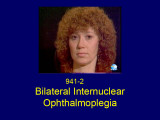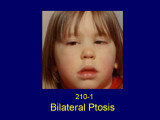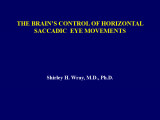Collection of materials relating to neuro-ophthalmology as part of the Neuro-Ophthalmology Virtual Education Library.
NOVEL: https://novel.utah.edu/
TO
- NOVEL728
| Title | Creator | Description | Subject | ||
|---|---|---|---|---|---|
| 76 |
 |
Best's Vittelform Maculopathy | Gregory P. Van Stavern, MD | This 14 year old presented with decreased vision, headaches and central scotomas. She was found to have bilateral papilledema related to IIH and also Best's vitilliform maculopathy. The maculas are commonly described as having a "fried egg" sunny side up appearance. | Best Macular Dystrophy |
| 77 |
 |
Bilateral Internuclear Ophthalmoplegia | Shirley H. Wray, MD, PhD, FRCP | This patient was seen at the Yale Eye Center at the age of 37. She had a long history of multiple sclerosis. At age 22, she had an acute attack of optic neuritis in the left eye which recovered fully within three weeks. Some months later she had a recurrent episode in the same eye, which also recove... | Bilateral Internuclear Ophthalmoplegia; Pendular Horizontal Oscillations; Lid Nystagmus; Upbeat Nystagmus; Botulinum Toxin Therapy; Multiple Sclerosis; Horizontal Pendular Nystagmus; Gaze Evoked Upbeat Nystagmus; Abducting Nystagmus |
| 78 |
 |
Bilateral Internuclear Ophthalmoplegia | Shirley H. Wray, MD, PhD, FRCP | Slideshow describing condition. | Abducting Nystagmus; Bilateral Internuclear Ophthalmoplegia; Botulinum Toxin Therapy; Gaze Evoked Upbeat Nystagmus; Horizontal Pendular Nystagmus; Lid Nystagmus; Multiple Sclerosis; Pendular Horizontal Oscillations; Upbeat Nystagmus |
| 79 |
 |
Bilateral Ptosis | Shirley H. Wray, MD, PhD, FRCP | A PowerPoint slideshow of diagnosed patients. | Bilateral Ptosis; Facial Weakness; Full Eye Movements; MuSK Antibody Myasthenia Gravis; Tongue Atrophy; Myasthenia Gravis |
| 80 |
 |
Bilateral Ptosis | Shirley H. Wray, MD, PhD, FRCP | This case, previously reported in 2007, is published courtesy of John Newsom-Davis, M.D., FRCP, FRS, CBE. Weatherall Institute of Molecular Medicine, John Radcliffe Hospital, Oxford. This patient was unusual in presenting in early childhood and the development of persistent facial muscle and tongue ... | Bilateral Ptosis; Full Eye Movements; Facial Weakness; Tongue Atrophy; MuSK Antibody Myasthenia Gravis |
| 81 |
 |
Birdshot | Gregory P. Van Stavern, MD | Birdshot Retinochoroidopathy is a posterior uveitis seen in women 30-60 years of age who present with floaters, changes in color vision, and difficulty with night vision. | Birdshot Choroidopathy |
| 82 |
 |
Bitemporal Hemianopia | Julia Mathew Padiyedathu, MD; Rudrani Banik, MD | Power point of case presentation of patient with painless progressive vision loss, optic nerve cupping with pallor and history of significant alcohol and tobacco use. Patient initially diagnosed at outside institution with normal tension glaucoma and toxic optic neuropathy. Exam suggests bitempora... | Ditemporal Visual Field Defect; Toxic Optic Neuropathy; Pituitary Adenoma; Compressive Optic Neuropathy |
| 83 |
 |
Blefarospasmo Essenziale Benigno (Italian) | North American Neuro-Ophthalmology Society | Uncontrolled blinking, squeezing, and eyelid closure that occurs in both eyes without an apparent environmental cause. | Blepharospasm; Patient Brochure |
| 84 |
 |
Blepharoespasm (Portuguese) | NANOS | Uncontrolled blinking, squeezing, and eyelid closure that occurs in both eyes without an apparent environmental cause. | Blepharospasm; Patient Brochure |
| 85 |
 |
Blepharospam (German) | NANOS | Uncontrolled blinking, squeezing, and eyelid closure that occurs in both eyes without an apparent environmental cause. | Blepharospasm; Patient Brochure |
| 86 |
 |
Blepharospasm | NANOS | Uncontrolled blinking, squeezing, and eyelid closure that occurs in both eyes without an apparent environmental cause. | Blepharospasm; Patient Brochure |
| 87 |
 |
Blepharospasm (French) | NANOS | Uncontrolled blinking, squeezing, and eyelid closure that occurs in both eyes without an apparent environmental cause. | Blepharospasm; Patient Brochure |
| 88 |
 |
Blepharospasm (Hebrew) | NANOS | Uncontrolled blinking, squeezing, and eyelid closure that occurs in both eyes without an apparent environmental cause. | Blepharospasm; Patient Brochure |
| 89 |
 |
Blepharospasm (Hungarian) | NANOS | Uncontrolled blinking, squeezing, and eyelid closure that occurs in both eyes without an apparent environmental cause. | Blepharospasm; Patient Brochure |
| 90 |
 |
Blepharospasm (Japanese) | NANOS | Uncontrolled blinking, squeezing, and eyelid closure that occurs in both eyes without an apparent environmental cause. | Blepharospasm; Patient Brochure |
| 91 |
 |
Blepharospasm (Simplified Chinese) | NANOS | Uncontrolled blinking, squeezing, and eyelid closure that occurs in both eyes without an apparent environmental cause. | Blepharospasm; Patient Brochure |
| 92 |
 |
Blepharospasm (Spanish) | NANOS | Uncontrolled blinking, squeezing, and eyelid closure that occurs in both eyes without an apparent environmental cause. | Blepharospasm; Patient Brochure |
| 93 |
 |
Blepharospasm (Telugu) | North American Neuro-Ophthalmology Society | Uncontrolled blinking, squeezing, and eyelid closure that occurs in both eyes without an apparent environmental cause. | Blepharospasm; Patient Brochure |
| 94 |
 |
Blepharospasm (Thai) | NANOS | Uncontrolled blinking, squeezing, and eyelid closure that occurs in both eyes without an apparent environmental cause. | Blepharospasm; Patient Brochure |
| 95 |
 |
Blepharospasm (Traditional Chinese) | NANOS | Uncontrolled blinking, squeezing, and eyelid closure that occurs in both eyes without an apparent environmental cause. | Blepharospasm; Patient Brochure |
| 96 |
 |
Blepharospasm - Large Print | NANOS | Uncontrolled blinking, squeezing, and eyelid closure that occurs in both eyes without an apparent environmental cause. | Blepharospasm; Patient Brochure |
| 97 |
 |
Blepharospasm Round Up | Shirley H. Wray, MD, PhD, FRCP | Slideshow describing condition. | Benign Essential Blepharospasm; Focal Dystonia; Lid Twitch; Psychogenic Blepharospasm; Voluntary Blinking |
| 98 |
 |
Blepharospasm Round-Up (Guest Lecture) | Shirley H. Wray, MD, PhD, FRCP | The patient is a 60 year old estate manager with a history of retinal laser therapy, dry eyes and age related bilateral ptosis. He carries a diagnosis of hilar lymphadenopathy due to sarcoid and has had cancer of the kidney. He presented in 1995 with a 6 month history of frequent blinking and spasms... | Benign Essential Blepharospasm; Focal Dystonia; Blepharospasm |
| 99 |
 |
Bony Anatomy | Ryung San Lee; James Brian Davis; Amanda Dean Henderson | These are multiple choice questions to Test Your Knowledge that go along with the Bony Anantomy topics covered in the NANOS Illustrated Curriculum. | Anatomy; Bone; Orbit; Skull |
| 100 |
 |
Brain Control of Horizontal Saccadic Eye Movements | Shirley H. Wray, MD, PhD, FRCP | PowerPoint lecture describing brain control of horizontal saccadic eye movements. | Acquired Ocular Motor Apraxia; Alzheimer's Disease with Mild Extrayramidal Signs; Cerebral Cortex; CNS Degeneration; Complete Paralysis of Voluntary Horizontal Saccades on Command to Look Left; Facial Tremor; Frontotemporal Dementia; Impaired Pursuit; Inability to Make a Refixation Saccade on Comma... |
